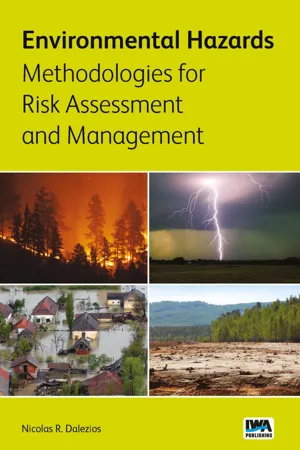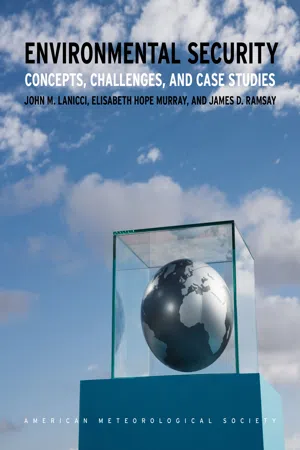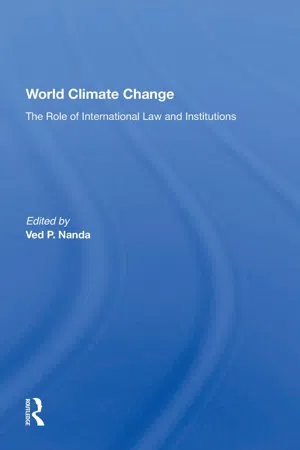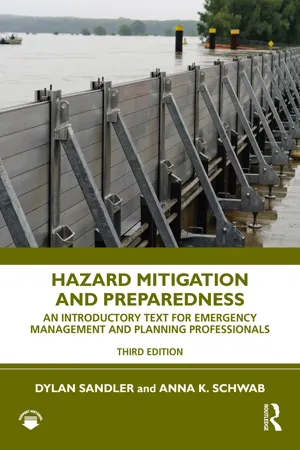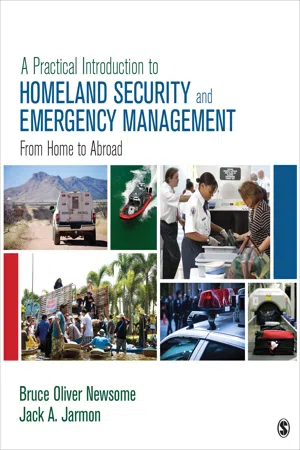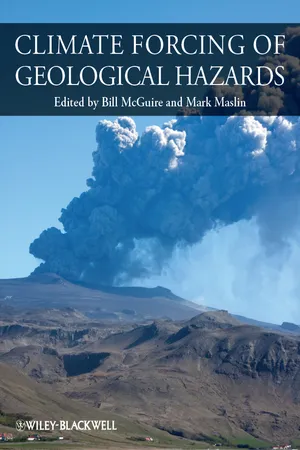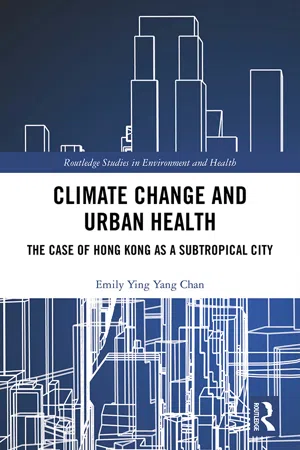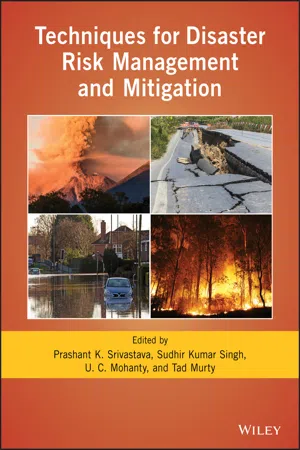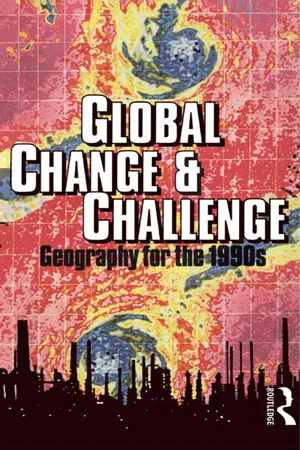Geography
Climatic Hazards
Climatic hazards refer to extreme weather events or conditions that pose a threat to human life, property, and the environment. These hazards can include hurricanes, tornadoes, droughts, floods, and heatwaves, among others. They are a significant concern for communities and governments, as they can cause widespread destruction and have long-term impacts on ecosystems and economies.
Written by Perlego with AI-assistance
Related key terms
Related key terms
1 of 4
Related key terms
1 of 3
12 Key excerpts on "Climatic Hazards"
- Nicolas R. Dalezios(Author)
- 2017(Publication Date)
- IWA Publishing(Publisher)
There is a large number of climate hazards with several and important impacts, which justifies the current concerns, as well as the future challenges for the global climate (Hobbs, 2005). Indeed, there are already very large differences in the magnitude and nature of hazard losses in several parts of the world, which are attributable not only to atmospheric and environmental, but mainly to socioeconomic factors (Degg, 1992). It is recognized that there is an increasing emphasis, which has shifted to the nature and alleviation of impacts and involves frequencies, magnitudes, causes, effects and behavior of Climatic Hazards, as well as perception, planning, preparedness, mitigation and control (UNISDR, 2015). Nevertheless, identification and assessment of hazardous events is not an easy task, although certain criteria are normally used, which may include disruption of services or communications and transportation, as well as property damage and economic loss, among others.In general, it is not easy to distinguish between atmospheric and non-atmospheric factors, which cause and produce Climatic Hazards (Maarouf & Munn, 2005). Indeed, increasing diachronic losses emphasize on the significance of socioeconomic factors resulting in vulnerability of communities to hazard events. It is mentioned that a broad distinction can be made between tropical cyclones affecting large areas and severe local storms, along with their associated weather extremes, which involve a sudden impact of very large energy amounts discharged over relatively short periods. On the other hand, specific hazard features result into cumulative hazards when they reach or exceed threshold magnitudes (Gentilli, 1979). Typical examples are heatwaves, cold spells, flood-producing rains, frosts, fogs, droughts, high winds, snow and ice associated with extratropical low-pressure systems, as well as climate change impacts. Furthermore, certain Climatic Hazards originate from human activity. Indeed, these hazards include biological hazards, impacts to human health, the possible risk of accidental modification of climatic patterns, as well as acid rain impacts on natural ecosystems.- eBook - ePub
Environmental Security
Concepts, Challenges, and Case Studies
- John Lanicci, Elisabeth Hope Murray, James D. Ramsay, John Lanicci, Elisabeth Hope Murray, James D. Ramsay(Authors)
- 2019(Publication Date)
- American Meteorological Society(Publisher)
For the purposes of this unit, we adopt the taxonomy used by the Centre for Research on the Epidemiology of Disasters (CRED; www.emdat.be), with some modifications, shown in Table 3.1.1. Natural hazards, which originate within the natural environment, can be classified into geophysical, hydrological, meteorological, climatological, biological, and extraterrestrial. Within the CRED taxonomy, we modify the definitions of meteorological and climatological hazards in order to distinguish between those that operate on short time scales as an individual extreme weather event 1 (e.g., tropical cyclone) and those that operate on longer time scales as a climatic anomaly 2 (e.g., drought). Both time scales are important to environmental security practitioners. We also modify the extraterrestrial hazard definition to emphasize solar disturbances (space weather) that can affect navigation, communication, and energy production and distribution systems. For the technological hazards, we adopt the CRED categories of industrial, transport, and miscellaneous accidents but add a fourth one for infrastructure failure, since critical infrastructure vulnerability is a very important concept in environmental security, especially in more-developed countries. Table 3.1.1. Hazard categories used in this chapter. A discussion of every hazard listed in Table 3.1.1 is beyond the scope of this unit. Instead, we select three natural hazards (tropical cyclones, floods, and drought), and for each, we provide a physical description, associated effects and impacts, and geographic distribution. Note that a tropical cyclone can be considered an extreme weather event, while a drought is a longer-term hazard from a climatic anomaly, and a flood can be caused either by a single extreme weather event (e.g., flash flood) or a climatic anomaly (e.g., excessive seasonal flood). 3.1.2 - Troy Sternberg(Author)
- 2017(Publication Date)
- Routledge(Publisher)
The HKH region represents a critical high-elevation environment in central Asia where cryospheric (frozen water) changes along with large-scale atmospheric, hydrological and ecological changes are already observable as warming temperature trends, glacier shrinkage and retreat, permafrost degradation, decreasing length of seasonal snow cover at higher elevations, earlier snowmelt runoff, degradation of grassland in the Tibetan Plateau, changes in Indian monsoonal patterns and local perceptions of a changing climate. Climate change impacts over the last several decades have been observed through significant temperature changes and also through variable rates of retreat of glaciers across the region (Bolch et al. 2012; Gardelle et al. 2012; Yao et al. 2012). Recent research analysing tropospheric temperatures reveals widespread annual warming rates over the entire HKH region of 0.21 ± 0.08°C/decade from 1979 to 2007 (Gautam et al. 2009, 2010). Even greater rates have been observed for the Nepalese Himalayan region specifically, with warming at approximately 0.6°C per decade from 1977 to 2000 (Shrestha et al. 1999). As the evidence suggests, potential impacts of a warming climate are greatest on regional hydro-climatology that may severely impact water resources in this region. Water-related hazards such as flash floods, outburst floods, landslides, debris flows and hazardous weather are projected to increase in the uplands. Recent flooding in the northwestern Himalayan region in the Uttarakhand State of India and western parts of Nepal exposed the vulnerability of these mountain regions to catastrophic flood disasters. Floods and cyclones are likely to increase in frequency, intensity and extent, and are expected to impact the lowland areas such as Bangladesh. At a basin scale, water availability and food security are also threatened by climate change owing to dependence on large-scale irrigation systems. This study provides analysis of climate-related hazards along with the susceptibility of harm and ability to cope of this region.Climatic Hazards and extreme events
Potential changes in climate have spurred a growing interest in Climatic Hazards and extremes that may have profound ecological as well as societal impacts globally (Easterling et al. 2000). One of the few available datasets on occurrences of hazards and disasters is the Emergency Events Database (Guha-Sapir et al. 2015; http://www.emdat.be- eBook - ePub
Environmental Hazards
Assessing Risk and Reducing Disaster
- Keith Smith(Author)
- 2013(Publication Date)
- Routledge(Publisher)
Hazards and disasters can no longer be viewed as one-off, site-specific events capable of regulation by local responses alone. In some instances the wider links and consequences are fairly clear; for example, global warming drives sea-level rise, which leads to increased risks from coastal floods. Other questions, such as the adverse effects of natural hazards on economic development, or on the future security of food and water supplies, are less self-evident. Unlike traditional ‘natural hazards’, many of these complex interrelationships have become prominent recently and thereExtreme geophysical events and severe system failures within a framework of global change and sustainability issues.Figure 1.2is a lack of historical experience and scientific record to enable understanding. As a result, some key issues — like the impact of climate change on environmental hazards — remain controversial within both scientific and political circles (see Chapter 14 ).Most environmental hazards can be placed on an approximate scale of causation, ranging from entirely natural forces to examples subject to considerable human influence (Figure 1.3 ) As the scale moves from rarer, uncontrolledA generalized spectrum of environmental hazards from physical to human causes. Risks with a high level of human causation are more readily accepted and more diffuse in terms of disaster impact.Figure 1.3natural events (asteroid impact, earthquake) through more ‘quasi-natural’ hazards (landslide, bushfire) towards more common technological-type hazards (transport accident, air pollution), so disaster impacts tend to become less concentrated within a particular community. As the extent of human causation grows, the risk spreads and the public tends to be more accepting of any loss. Entirely voluntary life-style hazards, such as cigarette smoking or mountaineering, are excluded from this book because they are wholly man-made, self-inflicted risks. Similarly, hazards of mass violence are excluded because crime, warfare and terrorism are intentional harmful acts on humans by humans. On the other hand, some societal characteristics do influence hazard impacts, either directly or indirectly. For example, certain epidemics of infectious disease are accepted in this book because they are not only a major cause of disaster deaths but are also related to environmental conditions. Factors such as poverty, ill-health and environmental degradation are not hazards in themselves but they have indirect effects by amplifying human vulnerability to hazardous events (see Chapter 3 - eBook - ePub
World Climate Change
The Role Of International Law And Institutions
- Ved Nanda(Author)
- 2021(Publication Date)
- Routledge(Publisher)
2As mammals, humans have the ability to maintain internal physiological environments that are markedly different from the outside environment. This ability is of course limited in many respects—excessive cold or warmth, cold combined with wind, extreme dryness or wetness, or lack of food or water can, for example, tax the unprotected human body beycnd its ability to cope. To avoid these limits, we have learned either to modify our local environment by wearing clothes and building shelters or to adapt our lifestyle and practices, for example, or by planting different crops, transporting food and other goods, or migrating. In essence, we engineer a "human climate" around ourselves in which we can live and work generally in greater comfort and safety than in the natural climate. The difference between the "human" and "natural" climates might be viewed as the climate's impact—that is, the adjustments we must make to ensure our survival and welfare amidst a constantly changing and sometimes hostile environment.A room is a good example of the human climate we construct for ourselves. Among other things, we build walls to stop the wind and help insulate from the cold or warmth (or pollution) of the outside. We add a roof to shelter from rain and snow, completing the enclosure. To provide for light and fresh air when we desire them, we place windows in our walls or skylights in our ceilings. As we often require more light than available naturally from the sun at particular times of the day or night, we generate "artifical" light. In higher latitudes, we find it necessary to burn fuels during some or all seasons to provide heat for our comfort; in equatorial latitudes, we have discovered that comfort, efficiency, and sometimes even survival depend on protection from the heat through ventilation or perhaps air conditioning. Since not every location receives adequate amounts of precipitation, we store and transport water, usually through a massive infrastructure of reservoirs, wells, and pipes. Many of the materials we use or consume last longer or have greater appeal if stored in an environment different from that normally found in a room; we therefore create "minienvironments" such as refrigerators, root and wine cellars, water heaters, and greenhouses that incorporate different combinations of temperature, humidity, and illumination. - eBook - ePub
Hazard Mitigation and Preparedness
An Introductory Text for Emergency Management and Planning Professionals
- Dylan Sandler, Anna K. Schwab(Authors)
- 2021(Publication Date)
- Routledge(Publisher)
Climate change impacts go far beyond the borders of the United States, affecting every country in the world. These impacts vary significantly from country to country, and in many cases those with fewer resources are most vulnerable. For example, many people on the African continent are projected to face increased water stress, creating significant public health, agricultural, and food security challenges. On the other hand, coastal areas of Asia will continue to face significant risks due to increased flooding.These changes are expected to have profound effects on ecological and human health. For example, as sea level rises, coastal communities are placed at much higher risk from hurricanes and coastal storms, along with the risk of slower-evolving impacts, such as long-term erosion and saltwater intrusion into local aquifers. Higher average temperatures also increase the likelihood of drought and wildfires, placing more communities in harm's way and posing new challenges for agriculture and other industries. These and other impacts of global climate changes on existing natural hazards are explored throughout Chapters 3 and 4 .While climate change is a global issue, the impacts are felt locally, with wide variations from one community to next. Many areas in the northeast are likely to see more flooding in coming years as the number of heavy downpours increases, while wildfire risks will continue to rise in areas of the southwest that are experiencing hotter, drier days. Since it is increasingly clear that climate change influences natural hazards risks, emergency managers, resources managers, and planners will need to anticipate climate change effects on the local community to effectively respond to hazards. These efforts to address climate change within the hazards management framework are explored throughout this book.SUMMARY
Every community faces potential exposure to hazards, both natural and human-made. Only when people are injured or killed and property is damaged by a hazard does a disaster occur. Due to patterns of population growth and development in the United States, disasters now occur more frequently than ever before. The impacts of climate change will only exacerbate the hazards we experience. Because we all pay for these disasters, directly or indirectly, it is in our best interests to prepare for disasters with responsible emergency management plans. Mitigation and preparedness strategies are critical ways of making a community more resilient against the impacts of hazards. - eBook - ePub
A Practical Introduction to Homeland Security and Emergency Management
From Home to Abroad
- Bruce Oliver Newsome, Jack A. Jarmon(Authors)
- 2015(Publication Date)
- CQ Press(Publisher)
6 Natural RisksLearning Objectives and Outcomes
At the end of this chapter, you should be able to understand the definitions, trends, distribution, and returns of- Natural hazards and threats in general
- Climate change in general
- Weather events in general
- Droughts and heat waves
- Storms, hurricanes, cyclones, and typhoons
- Tornadoes
- Floods
- Geological and geomorphic hazards (such as subsistence)
- Seismic hazards (mostly earthquakes)
- Volcanic hazards (such as ejected lava or ash)
- Fires (both human-caused and wild)
- Cosmic hazards (such as solar storms and meteors)
In September 2012, the World Economic Forum surveyed more than 1,000 experts and found them slightly more pessimistic for the next decade of global risks. This shift in opinion arose because persistent economic weakness decreases our ability to tackle environmental challenges. Respondents viewed the failure of climate change adaptation as the environmental risk with the most knock-on effects for the next decade (Howell, 2013).In 2013, the World Economic Forum identified the following six natural risks:- Extreme weather events
- Natural catastrophes of other kinds
- Man-made environmental catastrophes
- Major biodiversity loss and ecosystem collapse
- Water crises
- Failure of climate change mitigation and adaptation (World Economic Forum, 2014, p. 13)
- Fiscal crises in key economies
- Structurally high unemployment/underemployement
- Water crises
- Severe income disparity
- Failure of climate change mitigation and adaptation
- Greater incidence of extreme weather events...
- Global governance failure
- Food crises
- Failure of a major financial mechanism/institution
- Profound political and social instability (World Economic Forum, 2014, p. 9)
- eBook - ePub
- Bill McGuire, Mark A. Maslin, Bill McGuire, Mark A. Maslin(Authors)
- 2012(Publication Date)
- Wiley-Blackwell(Publisher)
2 Projected Future Climate Changes in the Context of Geological and Geomorphological HazardsFelicity Liggins1 , Richard A. Betts1 and Bill McGuire21 Met Office Hadley Centre, Exeter, UK2 Aon Benfield UCL Hazard Centre, Department of Earth Sciences, University College London, UKSummary On palaeoclimate timescales, enhanced levels of geological and geomorphological activity have been linked to climatic factors, including examples of processes that are expected to be important in current and future anthropogenic climate change. Planetary warming leading to increased rainfall, ice-mass loss and rising sea levels is potentially relevant to geospheric responses in many geologically diverse regions. Anthropogenic climate change, therefore, has the potential to alter the risk of geological and geomorphological hazards through the twenty-first century and beyond. Here, we review climate change projections from both global and regional climate models in the context of geohazards. In assessing the potential for geospheric responses to climate change, it appears prudent to consider regional levels of warming of 2°C above average pre-industrial temperature as being potentially unavoidable as an influence on processes requiring a human adaptation response within this century. At the other end of the scale, when considering changes that could be avoided by reduction of emissions, scenarios of unmitigated warming exceeding 4°C in the global average include much greater local warming in some regions. However, considerable further work is required to better understand the uncertainties associated with these projections, uncertainties inherent not only in the climate modelling but also in the linkages between climate change and geospheric responses.Introduction
Changes in many aspects of geological and geomorphological activity have been linked to climate variability on palaeoclimate timescales. This includes glacial lake outbursts and rock-dam failures, submarine and subaerial landslides, tsunamis and landslide ‘splash’ waves, seismic and volcanic activity, and gas hydrate destabilization. With human influence on climate now becoming significant and potentially very large, an emerging question is whether this could influence any or all of these processes and hence alter the risk of geological and geomorphological hazards. This field of study is very much in its infancy, but, as part of the background to other research, this chapter assesses climate change projections in the context of climate-related geological and geomorphological processes. - eBook - ePub
Climate Change and Urban Health
The Case of Hong Kong as a Subtropical City
- Emily Ying Yang Chan(Author)
- 2019(Publication Date)
- Routledge(Publisher)
4 Climate change and disastersThis chapter discusses the basic concepts of disasters and health, the relationship between climate change and trends of natural disaster occurrence, as well as population vulnerability towards these mega events.Disasters and extreme events
Natural hazards are extreme environmental impacting events that might cause large-scale human and economic losses to result in disasters. A hazard describes a phenomenon, substance, human activity, or condition that may cause injury, loss of life, property damage, loss of livelihoods and services, social and economic disruption, or long-term environmental damage. Meanwhile, a disaster is a serious disruption of the functioning of a community or a society involving human, economic, or environmental losses and impacts, which exceeds the ability of the affected community or society to cope using its own resources (United Nations International Strategy for Disaster Reduction [UNISDR], 2009). Earthquake, heatwave, and tropical cyclone are examples of “natural hazards” that might cause major human impact, but these natural phenomena may only be considered as a “disaster” when causing damages to human lives, health, or systems. Globally, different geographic locations might be affected by their underlying natural hazards. Depending on the socio-demographic characteristics, infrastructure, resilience, and response capacity, the outcome of a disaster might vary considerably and lead to different human impacts as a result.Natural disaster classification
Disaster may, in principle, be classified into two major subgroups, namely natural and man-made disasters. Whilst man-made disasters are originated from human activities such as technological accidents, transport accidents, and complex emergencies, natural disasters have specific characteristics and may be categorised into six main types according to their root causes. These include:• Geophysical: - eBook - ePub
Oceans and Human Health
Risks and Remedies from the Seas
- Patrick J. Walsh, Sharon Smith, Lora Fleming, Helena Solo-Gabriele, William H. Gerwick(Authors)
- 2011(Publication Date)
- Academic Press(Publisher)
Timmerman, 1981) . Next, we briefly cover some of the different ways vulnerability assessment is approached, particularly in relation to climate and human health.Natural hazard risk analysts tend to define vulnerability in biophysical terms. They seek to identify which specific biophysical hazards human populations are vulnerable to, what consequences might be expected as a result of these hazards, and where and when those impacts can be expected to occur (Jones, 2001 ; Timmerman, 1981) . In fields of health, hazard and risk researchers may analyze the likelihood of certain diseases occurring in a specific region under changing climate conditions or under conditions caused by climate variability (Epstein et al ., 1998;Martens et al ., 1995;McMichael et al ., 1996). This analysis may include, for example, the examination of increased incidences of malaria that occur during El Niño events in parts of South America, South Asia, and sub-Saharan Africa (Haines et al ., 2006;Martens et al ., 1997). Increased precipitation in these regions has been associated with increases in malaria vectors, and therefore greater incidence and thus regional vulnerability (in theory) to the disease during these episodes.A different approach toward examining vulnerability is taken by social science researchers who focus on the capacity of individuals or groups to deal with the impacts of natural hazards (Bowden et al ., 1981;Patz et al ., 2001). They are interested in understanding sociopolitical, socioeconomic, and cultural factors that make people more or less vulnerable to different risks, as well as differential abilities to cope with impacts. These can include factors such as access to treatment facilities and health care, access to freshwater sources and sanitation, population migration patterns, behaviors and lifestyles, availability of household level economic resources, and extent of social networks (Bohle et al ., 1994; Furgal and Seguin, 2006 ; Liverman, 1994) - Prashant K. Srivastava, Sudhir Kumar Singh, U. C. Mohanty, Tad Murty, Prashant K. Srivastava, Sudhir Kumar Singh, U. C. Mohanty, Tad Murty(Authors)
- 2020(Publication Date)
- Wiley(Publisher)
Environmental degradation is one of the major factors contributing to the vulnerability of agriculture because it directly magnifies the risk of environmental disasters. In order to ensure sustainability in agricultural production, a better understanding of the environmental hazards and disasters that impact agriculture is essential. A comprehensive assessment of impacts of natural disasters on agriculture requires a multidisciplinary, multisectoral, and integral approach involving several components and factors. Priority should be given to supporting applied research, since research is necessary to understand the physical and biological factors contributing to disasters. Community‐wide awareness and capacity building on environmental hazards and disasters, mainly for farmers and stakeholders, should also be included in any research effort. Programs for improving prediction and early warning methods, as well as dissemination of warnings, should be expanded and intensified. Moreover, efforts are required to determine the impact of disasters on natural resources.Recent research findings suggest that variability of climate, if encompassing more intense and frequent extremes, such as major large‐scale hazards like droughts, heat waves, or floods, results in the occurrence of natural disasters that are beyond our socioeconomic planning levels. It is estimated that about 65% of the global damage from natural disasters has a meteorological origin. Also, meteorological factors contribute to 87% of people affected by natural disasters and 85% of relevant deaths (UN/ISDR, 2015 ; EM‐DAT, 2009 ; WMO, 2004 ). This is expected to stretch regional response capabilities beyond their capacity and will require new adaptation and preparedness strategies (Salinger et al., 2005- eBook - ePub
Global Change and Challenge
Geography for the 1990s
- Robert Bennett, Robert Estall(Authors)
- 2012(Publication Date)
- Routledge(Publisher)
2 ENVIRONMENTAL HAZARDS David K.C. Jones The natural environment cannot be considered as neutral, merely serving as a backcloth for human activity. In reality there are complex two-way interactions between human societies and the natural environmental systems (atmosphere, hydrosphere, lithosphere and biosphere) which vary over time and space. As human societies have evolved, so their appraisals of the natural environment have changed, but such evaluations essentially focus on three main categories of interaction: environmental constraints, resources and hazards. Environmental constraints (or biophysical limits) are met where the natural environment poses difficulties for human activity. Dense forests, swamps, steep mountains, aridity (in deserts) and harsh polar climates are examples of ‘inhospitable’ conditions. Such constraints can be overcome only through human organisation, technology and the heavy investment of labour and capital. There are innumerable examples of forest clearance, land drainage and slope modification which preceded contemporary activity. Such human interventions perhaps have their most dramatic modern manifestations in the irrigation schemes that have caused the deserts to bloom in parts of the United States, Libya and Israel. In Chapter 1 environmental resources were defined as attributes of the natural environment that are valued by human societies at any point in time. But those environmental events that cause ‘costs’ to society by inflicting death, destruction, damage or disruption are usually referred to as natural hazards or environmental hazards. It is essential to recognise that both ‘resources’ and ‘hazards’ are human assessments or cultural appraisals and are, as such, intimately interrelated. Few phenomena can be deemed wholly good or wholly bad, the vast majority are combinations of the two
Index pages curate the most relevant extracts from our library of academic textbooks. They’ve been created using an in-house natural language model (NLM), each adding context and meaning to key research topics.
Explore more topic indexes
Explore more topic indexes
1 of 6
Explore more topic indexes
1 of 4
